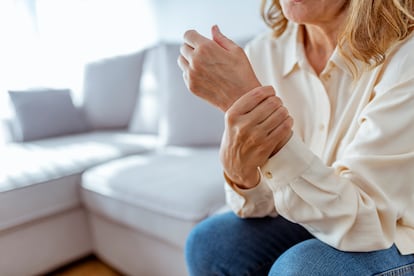The unstoppable rise of osteoarthritis: One billion to be affected by 2050
According to a new study, the disease affects 15% of the over-30 population and is expected to become more prevalent in the coming decades


Osteoarthritis is the most common form of arthritis and one of the leading causes of chronic pain and disability in adults. The cartilage of the affected joint breaks down, causing pain, stiffness, and swelling at the joint level, creaking when the joint is moved and decreasing function. It affects 15% of the over-30 population and has been rising nonstop. The U.S. Institute for Health Metrics and Evaluation (IHME) analyzed the prevalence of osteoporosis in more than 200 countries over the last 30 years and projected how the disease will evolve until 2050. The results were published Monday in the journal The Lancet Rheumatology. In 1990, it affected 256 million people in the world; in 2020, it affected 595 million; and by 2050 it is expected to affect nearly one billion.
Osteoporosis can damage any joint, but researchers focused on the hips, knees and hands, which tend to be the most common forms. It can be diagnosed before the age of 50, but older adults are most likely to suffer from it. In 2020, osteoarthritis was the seventh cause of disability in people over 70 years of age. In the study, the authors argue that preventing the disease or mitigating its effects “could prevent decades of reduced quality of life.” Of the data points mentioned in the study, the cost of the disease stands out. In 2016, the United States spent nearly $80 billion on health care costs, and in 2003, Hong Kong spent more than $400 million in direct and indirect expenses related to the disease.
According to the study, obesity is the main risk factor: in 2020, it was responsible for 20% of cases, 4% more than in 1990. Other causes mentioned are physically demanding jobs, practicing high-impact sports at an elite level, meniscectomies (the total or partial removal of a torn meniscus), the anatomy of the joints themselves, and muscle weakness. Also of importance are metabolic factors, such as the concentration of adipokines (a type of protein) and insulin resistance, which can predict knee osteoarthritis without needing a person’s body mass index, according to the study.
Currently, the options for dealing with osteoarthritis are exercise, physical therapy, the use of canes or splints, home adjustments, pain relievers and surgery (including joint replacement). However, these are temporary fixes as the disease has no cure. For this reason, the authors of the study have called for a review of the care provided to osteoporosis patients and of the treatments available to slow the progress of the disease.
Osteoarthritis affects women more than men: in 2020, 61% of cases were diagnosed in women. There are also geographic differences: osteoporosis occurs more in high-income countries in Asia Pacific, North America and Eastern Europe. In contrast, the lowest prevalence was observed in Southeast Asia and eastern and central sub-Saharan Africa. However, the scientists point out that this may be due to the differences in the data that could be collected from each country.
Osteoporosis occurs most commonly in the knees and hands. According to the investigation, the former is expected to affect 642 million people by 2050, while the latter will affect 279 million. What’s more, the rate of disability caused by both conditions has increased since 1990, by 69% and 57% respectively.
In addition to obesity, the factors that contributed most to the rise in osteoporosis were aging and population growth. Indeed, osteoporosis is expected to rise the least in areas where population decline has been forecast, such as central and eastern Europe. The disease is expected to rise the most in the central, eastern and western parts of sub-Saharan Africa, with prevalence jumping by 200%.
The authors explain that the greatest limitation of the research was the scarcity of data and accessing high quality data. In order to address the long-term burden of osteoarthritis, the researchers have called for prevention methods, greater access to the most effective treatments (such as joint replacement) and more research into the risk factors that cause and increase the severity of the condition.
Sign up for our weekly newsletter to get more English-language news coverage from EL PAÍS USA Edition
Tu suscripción se está usando en otro dispositivo
¿Quieres añadir otro usuario a tu suscripción?
Si continúas leyendo en este dispositivo, no se podrá leer en el otro.
FlechaTu suscripción se está usando en otro dispositivo y solo puedes acceder a EL PAÍS desde un dispositivo a la vez.
Si quieres compartir tu cuenta, cambia tu suscripción a la modalidad Premium, así podrás añadir otro usuario. Cada uno accederá con su propia cuenta de email, lo que os permitirá personalizar vuestra experiencia en EL PAÍS.
¿Tienes una suscripción de empresa? Accede aquí para contratar más cuentas.
En el caso de no saber quién está usando tu cuenta, te recomendamos cambiar tu contraseña aquí.
Si decides continuar compartiendo tu cuenta, este mensaje se mostrará en tu dispositivo y en el de la otra persona que está usando tu cuenta de forma indefinida, afectando a tu experiencia de lectura. Puedes consultar aquí los términos y condiciones de la suscripción digital.
More information
Archived In
Últimas noticias
Venezuela hardens its ‘revolutionary state’ project amid pressure from Trump
Sydney Sweeney, the actress praised by Trump: ‘Women are up against what society wants them to be’
The Bolsonaro surname: An advantage or liability in Brazil’s 2026 presidential elections?
Raúl Rocha, from jet-setting with Miss Universe to arms trafficking and fuel theft
Most viewed
- Reinhard Genzel, Nobel laureate in physics: ‘One-minute videos will never give you the truth’
- Pablo Escobar’s hippos: A serious environmental problem, 40 years on
- Charles Dubouloz, mountaineering star, retires at 36 with a farewell tour inspired by Walter Bonatti
- Why we lost the habit of sleeping in two segments and how that changed our sense of time
- The fall of a prolific science journal exposes the billion-dollar profits of scientific publishing










































